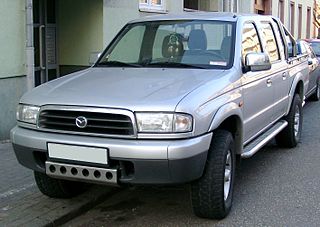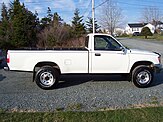
The Nissan Navara is a nameplate used for Nissan pickup trucks with D21, D22, D40 and D23 model codes. The nameplate has been used in Australia, New Zealand, Central America, South America, Asia, Europe, and South Africa. In North, Central and South America and some selected markets, it is marketed as the Nissan Frontier or Nissan NP300.

The Chevrolet Cavalier is a line of compact cars produced by Chevrolet. Serving as the replacement of the Chevrolet Monza, the Cavalier was the second Chevrolet model line to adopt front-wheel drive. Three versions of the Cavalier have been sold, including three generations sold in North America from model years 1982 to 2005, a version produced by SAIC-GM for China from 2016 to 2021, and a SAIC-GM version produced for Mexico since the 2019 model year.

The Ford F-Series is a series of light-duty trucks marketed and manufactured by Ford Motor Company since the 1948 model year. The F-Series is marketed as a range of full-sized pickup trucks positioned above the midsize Ranger but below the larger Super Duty in the Ford truck lineup. Alongside the F-150, the F-Series also includes the Super Duty series, which includes the heavier-duty F-250 through F-450 pickups, F-450/F-550 chassis cabs, and F-600/F-650/F-750 Class 6–8 commercial trucks.

The Chevrolet Colorado, is a series of compact pickup trucks marketed by American automaker General Motors. They were introduced in 2004 to replace the Chevrolet S-10 and GMC S-15/Sonoma compact pickups. The Colorado is named after the U.S. state of Colorado, while the Canyon would be the deep chasm between cliffs.

Ford Courier is a model nameplate used by Ford since the early 1950s. The Courier moniker has been used on a variety of vehicles all around the world since it was first used in North America for a sedan delivery. The Courier nameplate was also used by Ford for a series of compact pickup trucks and would also see use by Ford of Europe denoting a Fiesta-based panel van. Ford Brazil used the nameplate for a Fiesta-based coupe utility pickup marketed across Latin America.

The Ford Ranger is a range of pickup trucks manufactured and marketed by Ford Motor Company in North and South America under the Ford Ranger nameplate. Introduced in early 1982 for the 1983 model year, the Ranger is currently in its fourth generation. Developed as a replacement for the Mazda-sourced Ford Courier, the model line has been sold across the Americas; Ford of Argentina began production of the Ranger for South America in 1998.

The Dodge Dakota, known as the Ram Dakota for the final two years of production, is a mid-size pickup truck from Chrysler's Ram division. The first Dakota was introduced in late 1986 as a 1987 model. From its introduction through 2009, it was marketed under the Dodge brand, and for the final two years under the Ram brand.

The Toyota Tacoma is a pickup truck manufactured by Japanese automobile manufacturer Toyota since 1995. The first-generation Tacoma was classified as a compact pickup. The second generation and third generation models are classified as mid-sized pickups. The Tacoma was Motor Trend's Truck of the Year for 2005.

The Nissan Titan is a full-size pickup truck manufactured in the United States for the North American market by Nissan. It was named after the Titans of Greek mythology.

The Toyota Sequoia is a full-size SUV manufactured by Toyota mainly for the North American market since 2000 for the 2001 model year, being derived from the Tundra pickup truck. It is the second largest SUV ever produced under the Toyota brand, after the Japan-exclusive, military-focused Mega Cruiser.

The Toyota Tundra is a pickup truck manufactured in the United States by the Japanese manufacturer Toyota since May 1999. The Tundra was the second full-size pickup to be built by a Japanese manufacturer, but the Tundra was the first full-size pickup from a Japanese manufacturer to be built in North America. The Tundra was nominated for the North American Truck of the Year award and was Motor Trend magazine's Truck of the Year in 2000 and 2008. Initially built in a new Toyota plant in Princeton, Indiana, production was consolidated in 2008 to Toyota's San Antonio, Texas, factory.

The Toyota 4Runner is an SUV manufactured by the Japanese automaker Toyota and marketed globally since 1984, across five generations. In Japan, it was marketed as the Toyota Hilux Surf and was withdrawn from the market in 2009. The original 4Runner was a compact SUV and little more than a Toyota Hilux pickup truck with a fiberglass shell over the bed, but the model has since undergone significant independent development into a cross between a compact and a mid-size SUV. All 4Runners have been built in Japan at Toyota's plant in Tahara, Aichi, or at the Hino Motors plant in Hamura.

The Toyota Hilux, stylized as HiLux and historically as Hi-Lux, is a series of pickup trucks produced and marketed by the Japanese automobile manufacturer Toyota. The majority of these vehicles are sold as pickup truck or cab chassis variants, although they could be configured in a variety of body styles.

The Mazda B series is a series of pickup trucks that was manufactured by Mazda. Produced across five generations from 1961 to 2006, the model line began life primarily as a commercial vehicle, slotted above a kei truck in size. Through its production, Mazda used engine displacement to determine model designations; a B1500 was fitted with a 1.5 L engine and a B2600, a 2.6 L engine.

The Ford Super Duty is a series of heavy-duty pickup trucks produced by the Ford Motor Company since the 1999 model year. Slotted above the consumer-oriented Ford F-150, the Super Duty trucks are an expansion of the Ford F-Series range, from F-250 to the F-600. The F-250 through F-450 are offered as pickup trucks, while the F-350 through F-600 are offered as chassis cabs.

The Isuzu Faster is a pickup truck that was manufactured and marketed by Isuzu between 1972 and 2002 over three generations. The Faster was succeeded worldwide by Isuzu D-Max, except in Japan and North America.

The Volkswagen Amarok is a pickup truck produced by Volkswagen Commercial Vehicles since 2010. It is a body-on-frame truck with double-wishbone suspension at the front and leaf springs at the rear. The Amarok range consists of single cab and double cab, combined with either rear-wheel drive or 4motion four-wheel-drive, and is powered by turbocharged petrol or turbocharged direct injection (TDI) diesel engines.

The Suzuki Equator was a mid-size pickup truck based on the Nissan Frontier and assembled by Nissan. It was first sold in the US for the 2009 model year with MSRPs starting at $17,220, and made its debut at the 2008 Chicago Auto Show.

The eleventh generation of the Ford F-Series, marketed as the Ford Lobo in Mexico, is the company's line of light-duty pickup trucks manufactured and marketed by Ford for the 2004 to 2008 model years. With a redesigned body and chassis, and marketed as its F-150 line, between the company's Ranger and the Super Duty trucks.

The Ford Maverick is a four-door, compact pickup truck manufactured and marketed by Ford Motor Company. It was unveiled on June 8, 2021, as Ford's smallest truck, slotted below the mid-size Ford Ranger.




























